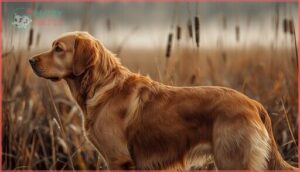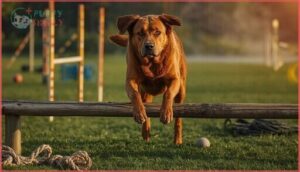This site is supported by our readers. We may earn a commission, at no cost to you, if you purchase through links.

Two Newfoundland puppies pulled from a sinking ship in 1807 became the unlikely foundation of one of America’s toughest working retrievers. Bred with local dogs along Maryland’s marshy shores, these survivors gave rise to the Chesapeake Bay Retriever, a dog built to break ice, brave frigid waters, and retrieve hundreds of ducks in a single day.
That rugged heritage shows in every aspect of the breed today. The Chessie’s oily, waterproof coat, webbed feet, and unwavering determination make it stand apart from other retrievers.
If you’re considering this breed, you’ll need to understand what centuries of harsh conditions bred into these dogs—and whether your lifestyle can meet their considerable physical and mental needs.
Table Of Contents
- Key Takeaways
- Chesapeake Bay Retriever Origins and History
- Physical Characteristics and Appearance
- Temperament and Personality Traits
- Health, Nutrition, and Grooming Needs
- Exercise, Training, and Daily Life
- Frequently Asked Questions (FAQs)
- What is the Chesapeake Bay retriever guide?
- Where did the Chesapeake Bay Retriever come from?
- Are Chesapeake Bay Retrievers good dogs?
- Can Chesapeake Bay Retrievers adapt to apartment living?
- How do Chessies handle hot and humid climates?
- Do Chessies get along well with cats?
- What are the best activities for senior Chessies?
- Conclusion
Key Takeaways
- The Chesapeake Bay Retriever descended from two Newfoundland puppies rescued from an 1807 shipwreck, bred with local dogs to create America’s toughest water retriever with an oily, waterproof coat and webbed feet designed for breaking ice and retrieving hundreds of ducks daily in frigid conditions.
- This breed demands exceptional commitment with 1-2 hours of daily exercise, including swimming, consistent training to manage their independent streak and protective instincts, and mental stimulation to prevent boredom-driven behavioral problems that softer retrievers wouldn’t display.
- Chesapeakes bond intensely with their families but show natural wariness toward strangers, requiring early socialization before 16 weeks to reduce anxiety by 65% and prevent same-sex aggression in multi-dog households, while their prey drive needs careful management around cats and small pets.
- These dogs face genetic health concerns, including a 20% risk of joint dysplasia and cancer as the leading cause of death at 28.5%, requiring genetic screening, weight management, and preventative care to reach their 10-13 year lifespan while maintaining their waterproof coat through minimal bathing every 3-4 months.
Chesapeake Bay Retriever Origins and History
The Chesapeake Bay Retriever’s story begins along the rugged shores of a 200-mile estuary where Maryland and Virginia meet. This breed didn’t happen by accident—it was carefully shaped by duck hunters in the 1800s who needed a dog tough enough to handle icy waters and relentless conditions.
The Chesapeake Bay Retriever was forged by 1800s duck hunters along Maryland’s icy estuary shores to survive relentless conditions
Understanding where these dogs came from helps explain why they’re built the way they’re and why they act the way they do.
Development in The Chesapeake Bay Region
During the early 1800s, the Chesapeake Bay Retriever origin took shape when two Newfoundland-type puppies, rescued from a 1807 shipwreck off Maryland, were bred with local spaniels across West River. These regional bloodlines served market hunting needs, as waterfowl sales fueled coastal economies.
By 1877, distinct types unified into one breed, reflecting maritime adaptation and early breed preservation efforts in the Chesapeake Bay area. These dogs are well-suited for the harsh hunting conditions of the area.
Ancestral Breeds and Purpose
The breed’s foundation began with St. Johns Dogs from that 1807 rescue, crossed with local retrievers to improve cold-water performance. Spaniel influence refined their soft mouth for retrieving waterfowl, while hound contributions sharpened scenting ability. This purposeful selection created a dog breed origin story centered on hunting practicality.
As an intelligent breed, they’re also known to be affectionate. Their retriever impact shaped American gundog standards, as Chesapeake Bay Retriever history shows adaptability through intentional crossbreeding.
Role in American Hunting Culture
By the late 1800s, these hunting dog breeds routinely retrieved hundreds of waterfowl daily for market hunters across the Chesapeake Bay. This waterfowl heritage shaped their reputation as top retrieving dogs in harsh conditions.
Field trials emerged in the 1930s to test their abilities, while modern hunting emphasizes versatility.
The breed adaptation continues supporting economic impact through regional kennels and clubs, proving duck hunting demands resilience you’ll find in few other breeds.
Recognition and Breed Standards
As demand for these retrievers grew, formal recognition became inevitable. The American Kennel Club officially recognized the Chesapeake Bay Retriever breed in 1918, establishing dog breed standards that define breed characteristics today.
Conformation judging evaluates whether your dog meets the breed ideal across organizations:
- Males should weigh 65-80 pounds; females 55-70 pounds
- Yellow or amber eyes signal proper Chesapeake Bay Retriever characteristics
- Water-resistant double coats remain essential for breed evolution
- Courage and willingness distinguish temperament in standard variations
AKC recognition cemented their status among America’s sporting breeds.
Physical Characteristics and Appearance
The Chesapeake Bay Retriever has a distinctive look that sets it apart from other retrievers. From its muscular build to its water-resistant coat, every physical trait has a purpose rooted in its working heritage.
Let’s examine the key characteristics that define this rugged breed’s appearance.
Size, Build, and Proportions
When you examine a Chesapeake Bay Retriever, you’ll notice ideal proportions that create an almost square silhouette. Males stand 23–26 inches tall and weigh 65–80 pounds, while females measure 21–24 inches and 55–70 pounds, showing clear sexual dimorphism.
Their muscular build features substantial bone density, with a broad chest extending to the elbow and powerful hindquarters that reach full development during growth stages between 12–18 months.
Coat Type, Color, and Texture
Your Chesapeake Bay Retriever’s double coat is truly engineered for function. The harsh, wavy outer layer pairs with a dense, woolly undercoat, creating a waterproof barrier through natural oily texture.
You’ll find coat color in three standard shades: brown, sedge, or deadgrass—each helping your dog blend into marshy terrain. The coat shouldn’t exceed 1½ inches, with moderate feathering allowed on hindquarters.
This unique texture faults include curly coats, which violate breed standards.
Unique Features (webbed Feet, Amber Eyes)
Two standout traits define your Chesapeake Bay Retriever’s appearance: those large webbed feet and striking amber hue eyes. The webbed feet function like natural swim fins, propelling your dog through icy waters with considerable power. Meanwhile, those bright amber eyes aren’t just beautiful—they improve contrast sensitivity in foggy marshlands.
These functional adaptations follow strict breed standard traits, requiring regular feature health maintenance between toes to prevent debris buildup.
Male Vs. Female Differences
When choosing between a Chesapeake Bay Retriever male vs female, you’ll notice clear size comparison differences—males stand 23-26 inches and weigh 65-80 pounds, while females measure 21-24 inches at 55-70 pounds.
Dog temperament also varies: females generally show better training ease and focus, whereas males display stronger territorial instincts. Activity needs remain high for both, though these dog breed temperament variations affect your daily routine.
Temperament and Personality Traits
Understanding the Chesapeake Bay Retriever’s personality helps you decide if this breed fits your lifestyle. These dogs combine intelligence with a strong protective instinct, creating a unique temperament that’s both rewarding and demanding.
Let’s break down the key personality traits you’ll encounter with a Chessie.
Intelligence and Trainability
Chesapeake Bay Retriever intelligence ranks 27th among breeds, meaning your dog generally grasps new commands after 15 to 25 repetitions. Their problem-solving skills shine in working performance, though training challenges arise from their independent streak.
For best results with dog training:
- Start positive reinforcement training early with basic commands
- Use food rewards consistently to improve command comprehension
- Provide mental stimulation daily to prevent behavioral issues
- Maintain patience through their occasional stubborn moments
Dog temperament here leans confident yet sensitive.
Loyalty and Affection for Family
Your dog’s loyal temperament runs deep, with over 83% of owners reporting strong attachment behaviors like room-to-room following. These Chesapeake Bay Retriever families experience striking emotional sensitivity—your Chessie reads mood shifts and offers comfort during distress. Early socialization strengthens these bonding behaviors considerably.
| Affection Patterns | How They Show It |
|---|---|
| Physical Contact | Leaning, head-laying on owners |
| Protective Instincts | Watchful behavior toward home (78% of literature) |
| Emotional Support | Nuzzling during owner stress |
Dog loyalty with Chesapeake Bay Retriever and family bonds intensifies through daily interactive activities, making these dog families uniquely connected.
Behavior With Strangers and Other Pets
While your Chessie bonds fiercely with you, stranger wariness defines their protective instinct. Only 16% greet newcomers warmly without early dog socialization. Multi-pet homes succeed when you introduce animals before 16 weeks—79% then coexist peacefully despite prey drive in 68% of the breed. Chesapeake Bay Retriever temperament shifts dramatically with socialization impact: exposure to 20+ people by 12 weeks cuts stranger-directed anxiety by 65%.
- Early socialization before 4 months reduces predatory behaviors toward cats and small pets by 54%
- Same-sex aggression appears in 33% of multi-dog households without structured introductions
- Bite incidents remain rare at 0.09 per 100 dogs annually, lower than similar working breeds
Suitability for Families and Children
Your home becomes their kingdom when you combine affectionate family dynamics with the Chesapeake Bay Retriever temperament’s natural loyalty. Supervised playtime is non-negotiable—despite 79% coexisting peacefully with small children, that protective instinct needs boundaries.
Exercise family integration through swimming or fetch, and you’ll channel their energy productively. Training compatibility improves when everyone reinforces commands. Early dog socialization transforms them into confident family pets who balance watchfulness with warmth.
Common Temperament Challenges
Even loving families hit roadblocks with Chesapeake Bay Retriever temperament challenges. Fear-based aggression and socialization issues surface without early exposure—25-35% show wariness toward unfamiliar dogs. Stubbornness tests your patience during training, while separation anxiety triggers destructive behavior when you’re gone.
Resource guarding appears in 20-30% of Chesapeakes, and that protective instinct can increase emotional complexity, demanding consistent boundaries and professional guidance when dog behavior escalates.
Health, Nutrition, and Grooming Needs
Keeping your Chesapeake Bay Retriever healthy means understanding what can go wrong and how to prevent it. You’ll need to pay attention to their diet, coat maintenance, and routine care to help them live a long, active life.
Here’s what you should know about managing their health, nutrition, and grooming needs.
Common Health Issues and Genetic Concerns
Like any purebred dog, your Chesapeake Bay Retriever may face hereditary health issues that genetic screening can help identify early. Joint dysplasia affects up to 20% of dogs, while autoimmune risks include thyroid problems in 5–8% of the breed. Cancer prevalence is significant—it’s the leading cause of death at 28.5%.
These dog health concerns and lifespan factors make preventative care essential for your companion.
Diet and Nutritional Requirements
Your Chesapeake Bay Retriever’s diet should include 20–30% protein from quality sources like chicken or salmon, alongside 15–20% fats rich in omega fatty acids. Feed measured portions twice daily to prevent bloat and maintain energy.
- Protein Sources: Real meat promotes muscle health and repair
- Fat Intake: Omega-3s keep coats shiny and joints strong
- Toxic Foods: Never feed chocolate, grapes, onions, or cooked bones
Grooming Routines and Coat Care
Maintaining your Chesapeake Bay Retriever’s waterproof coat requires weekly brushing with a rubber curry or slicker brush to remove dead hair and distribute natural oils. Increase brushing frequency during spring and fall shedding seasons.
Bathe only every three to four months using mild, dog-specific shampoo to preserve the coat’s protective oils. Trim nails every four to six weeks for comfort.
Lifespan and Preventative Care
Your Chesapeake Bay Retriever can live 10 to 13 years with proper care. Longevity factors include genetic screening for hip dysplasia and degenerative myelopathy before breeding.
Focus on dental health through daily brushing, weight management to prevent joint issues, and bloat prevention by avoiding raised food bowls.
Regular vet checkups catch Chesapeake Bay Retriever health conditions early, protecting against common dog health problems like cancer and arthritis.
Exercise, Training, and Daily Life
A Chesapeake Bay Retriever isn’t a couch potato—this breed needs serious daily activity and a structured routine to stay happy. Training requires consistency and respect for their independent streak, while mental challenges keep their sharp minds engaged.
Here’s what you need to know about keeping your Chessie physically fit, mentally sharp, and well-adjusted in everyday life.
Exercise Requirements and Activity Levels
Your Chesapeake Bay Retriever needs 20 to 40 minutes of daily exercise, though many owners provide an hour for best health. Swimming ranks as their favorite activity, complementing walks and retrieving games perfectly.
Mental stimulation through puzzle toys prevents boredom-related issues common in this intelligent breed.
Regular physical activity reduces obesity risk and behavioral problems, supporting their active lifestyle while promoting longevity and overall well-being.
Recommended Training Approaches
Training your Chesapeake Bay Retriever works best when you start early obedience sessions in a controlled environment like your fenced yard. Positive reinforcement training with food rewards and verbal praise builds strong command reliability.
Structured programs help you channel their natural instincts through retrieving activities. Keep sessions short, consistent, and reward good behaviors immediately.
Professional guidance through dog training tips enhances your early socialization efforts considerably.
Mental Stimulation and Enrichment
Your Chesapeake Bay Retriever’s brain needs as much work as their body does. Daily mental stimulation through puzzle toys and scent work prevents boredom-driven behaviors while sharpening cognitive function.
Agility training and socialization games provide excellent brain workouts that complement positive reinforcement training methods.
Spending 30 minutes to an hour on focused enrichment activities helps delay cognitive decline and keeps your dog mentally sharp throughout their life.
Living Environment Considerations
After those enrichment sessions, your Chesapeake Bay Retriever will crave open spaces to stretch, jump, and swim. Space requirements aren’t just a preference—they’re part of this breed’s DNA.
Climate adaptation comes naturally, but hot weather needs extra care. Without regular exercise access or social compatibility, a Chessie can grow restless indoors. Prioritize dog exercise needs and balanced indoor enrichment.
Frequently Asked Questions (FAQs)
What is the Chesapeake Bay retriever guide?
This guide covers breed history, physical traits, temperament, health concerns, nutritional needs, grooming routines, exercise requirements, and training approaches—everything you need to understand and care for this distinctive American waterfowl retriever.
Where did the Chesapeake Bay Retriever come from?
In 1807, two Newfoundland puppies survived a shipwreck off Maryland’s coast. Sailor and Canton became founding dogs, bred with local coonhounds by market hunters who shaped this resilient retriever.
Are Chesapeake Bay Retrievers good dogs?
Yes, they make excellent family pets for active households. Their temperament overview reveals loyalty and protective instincts, though first-time owners should note breed suitability depends on providing consistent training and ample exercise opportunities.
Can Chesapeake Bay Retrievers adapt to apartment living?
While these powerful water dogs can technically squeeze into smaller spaces, it’s like asking a marathon runner to train in a closet.
Chesapeake Bay Retrievers need one to two hours of daily exercise, making apartment living challenging without dedicated owner lifestyle adjustments.
How do Chessies handle hot and humid climates?
Chessies have moderate heat tolerance due to their dense, water-resistant coat, originally designed for cold water retrieval.
You’ll need cooling strategies like shade, fresh water, and early-morning exercise to keep them comfortable in hot, humid conditions.
Do Chessies get along well with cats?
Predisposition and prey drive influence compatibility, but socialization importance can’t be overstated. Many dog owners report positive experiences when introducing their dog family members early.
Training techniques and temperament factors determine success more than dog characteristics alone.
What are the best activities for senior Chessies?
Your senior Chesapeake Bay Retriever benefits most from low-impact exercise like swimming, gentle walks, mental stimulation through puzzle toys, adapted play with softer retrieves, and lifestyle adjustments supporting joint health and mobility.
Conclusion
The Chesapeake Bay Retriever isn’t a dog you adopt on a whim—this breed demands more commitment than a dozen softer retrievers combined.
Their legendary work ethic, protective instincts, and endless stamina require owners who can match their intensity with structure, activity, and patience.
If you’re prepared to honor what centuries of brutal waterfowl work bred into these dogs, you’ll gain a loyal companion unlike any other retriever you’ve known.
- https://www.wisdompanel.com/en-us/dog-breeds/chesapeake-bay-retriever
- https://showsightmagazine.com/dog-breeds/chesapeake-bay-retriever/
- https://amchessieclub.org/breed-standard/
- https://oxfordlabs.com/owners-and-breeders/how-common-thyroid-disease-my-breed/sporting/chesapeake-bay-retriever
- https://www.webmd.com/pets/dogs/what-to-know-about-chesapeake-bay-retrievers













